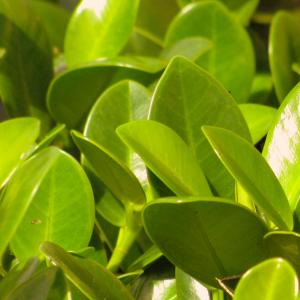Plant Experience
Detail
Leaf loss is typically the first sign of stress a ficus tree exhibits, but proper care can help minimize any problems. It is not uncommon for a tree to lose one-quarter of its leaves even after a simple environmental change such as switching rooms, but proper watering and temperature regulation can help mitigate additional stress. If the leaves turn yellow just prior to dropping off, it is a sign of over-watering, while dull leaves may indicate a lack of essential nutrients.
Do rotate your Ficus plant to ensure that all sides get their turn to absorb directional light.
Ficus trees have vigorous root growth and may easily become pot bound. Replanting the tree is easy, and should be done every one to two years depending on its growth. Choose a pot at least two inches wider in diameter than the previous pot to ensure plenty of space for the tree to grow. For many trees, this will need to be done soon after they have been purchased as they are moved to a new home.
Regular pruning is necessary to retain the tree’s shape. Prune back to 2 leaves after 6-8 leaves have grown. Leaf pruning can be used to reduce leaf size, as some ficus bonsai species normally grow large leaves. If a considerable thickening of the trunk is desired, the ficus can be left to grow freely for one or two years. The strong cuts that are necessary afterwards don't affect the ficus' health and new shoots will grow from old wood. Larger wounds should be covered with cut paste.
Regular misting or setting the Ficus tree on a pebble tray filled with water is a great way to increase their humidity. But keep in mind that while they like high humidity, they do not like overly wet roots. Therefore, when watering, always check the top of the soil first. If the top of the soil is wet, do not water as this means they have enough moisture. If the top of the soil feels dry to the touch, this indicates that they need water.
Do rotate your Ficus plant to ensure that all sides get their turn to absorb directional light.
Ficus trees have vigorous root growth and may easily become pot bound. Replanting the tree is easy, and should be done every one to two years depending on its growth. Choose a pot at least two inches wider in diameter than the previous pot to ensure plenty of space for the tree to grow. For many trees, this will need to be done soon after they have been purchased as they are moved to a new home.
Regular pruning is necessary to retain the tree’s shape. Prune back to 2 leaves after 6-8 leaves have grown. Leaf pruning can be used to reduce leaf size, as some ficus bonsai species normally grow large leaves. If a considerable thickening of the trunk is desired, the ficus can be left to grow freely for one or two years. The strong cuts that are necessary afterwards don't affect the ficus' health and new shoots will grow from old wood. Larger wounds should be covered with cut paste.
Regular misting or setting the Ficus tree on a pebble tray filled with water is a great way to increase their humidity. But keep in mind that while they like high humidity, they do not like overly wet roots. Therefore, when watering, always check the top of the soil first. If the top of the soil is wet, do not water as this means they have enough moisture. If the top of the soil feels dry to the touch, this indicates that they need water.
Album (1)

Plants Encyclopdias
2016-08-17

Name: Chinese Banyan
Latin: Ficus microcarpa
Origin: Asia
Plant height: 60 - 150 cm
Reproduction: #Layering
Difficulty level: #Medium
Tags: #Asia #Ficusmicrocarpa

Latin: Ficus microcarpa
Origin: Asia
Plant height: 60 - 150 cm
Reproduction: #Layering
Difficulty level: #Medium
Tags: #Asia #Ficusmicrocarpa

Elite Article













